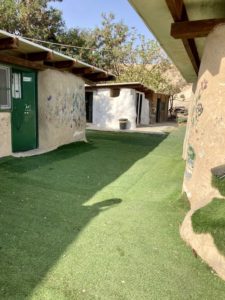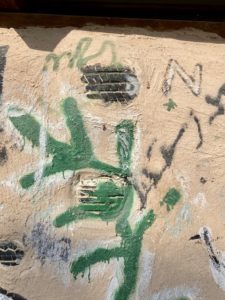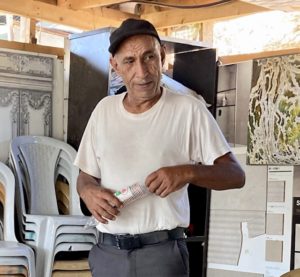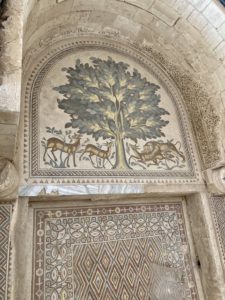Our bus traveled around Jerusalem, through the industrial edge of Bethany and on switchback roads with grades of 5/0 or higher to our first stop, Khan al-Ahmad, a Bedouin community of about 200 people. Because there is no access from the highway, we got off the bus on the side of the highway, walked past a skinny donkey and past sheep in a covered pen. We waved at a few women and young children on our way to the “tire school.” Since this village has been under an Israeli demolition order for years, and no permanent construction is allowed, the community built a school of tires and dirt, covering the walls with plaster and concrete. There are 200 children attending from several nearby Bedouin communities. For more info: https://www.unrwa.org/newsroom/features/rubber-tyre-school
school with artificial turf (left) and detail of tires in wall (right)
After seeing the school, we were welcomed into a covered seating area to hear from Eid Khamis Jahaleen, the community leader. Our host poured small paper cups of strong hot coffee for us, and later we were offered sweet Palestinian hot tea.
Eid is a very intelligent but down-to-earth man, and while he has visited several U.S. States and speaks English, for us he spoke in Palestinian Arabic and our guide translated. The story of his community is like that of other Bedouin communities in Palestine- threats, intimidation, removal from traditional lands to places where there is not enough water (even though nearby illegal settlements get water), no open space for their livestock, and no access to markets (no access to the highway, no permits to travel). The community has been ordered to move and been given two options: 1) 150 meters (less than 500 feet) from a garbage dump, where a soil test shows it is dangerous for people and animals, or 2) next to the sewage collection center for nearby illegal settlements. Both options would force them to sell their animals. The community has brought forward 14 master plans and all have been rejected. The land where the Bedouins live are strategically located at a narrow point in the West Bank, and is the only thing preventing the West Bank being divided into north and south portions. Eid gave us some examples of the injustices: solar panels donated by an international organization in 2015 were confiscated by the Israeli military, the electric grid is on adjacent property but no electricity is available to them, another organization provided outdoor bathrooms and mobile homes – these were demolished or some given to settlers. If a Palestinian ID is presented for health care from Israelis, even emergency care, they are often refused and Palestinian ambulances must have specific approval to come through the checkpoints. From 1967 to the present, the number of building permits given to Bedouins is 0.
Eid Khamis Jahaleen
We learned so much from Eid and his community. Our next stop was a short, hot hike up to view St. George’s Monastery, where our guide, Usama, read us Jesus’ response when asked “Who is our neighbor?”
Before a wonderful lunch in Jericho, we stopped at the Greek Orthodox Church with its wonderful icons and where stands the remains of the sycamore tree that Zacchaeus climbed. After lunch we visited the overlook of the Mount of Temptation and the Orthodox Monastery clinging to the mountainside. Looking in the other direction, and a short walk, we could almost see the Jordan River and the city of Amman. Too dusty and hazy!
Our last stop was Hisham’s Palace, an early Islamic site from the 8th Century with beautiful mosaic floors and baths. We had to make do with bottles of frozen water available from the shopkeeper.
Mosaic from Hisham’s Palace
Mary Buchele
When you meet anyone, remember it is a holy encounter. And as you see them you will see yourself. ~ A Course In Miracles




